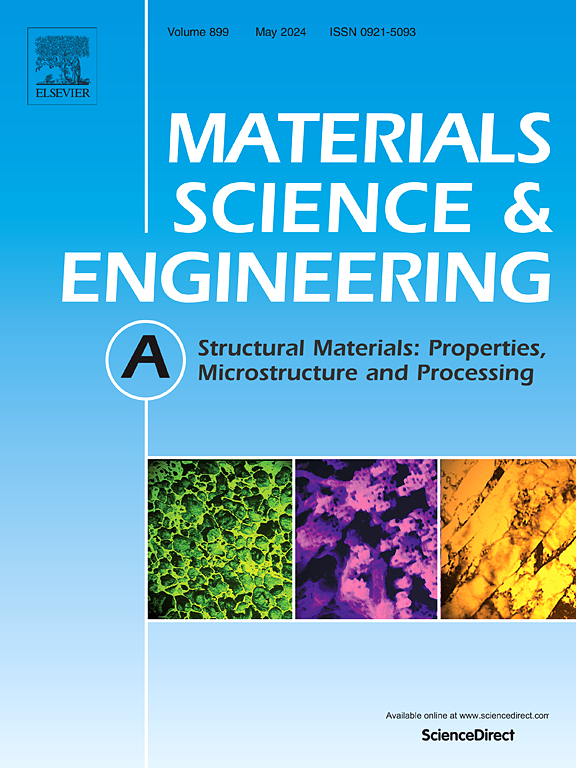Root inspired in situ interlocked interface for strength and ductility combination of refractory high-entropy alloys/Ni composites by activated sintering
IF 6.1
2区 材料科学
Q1 MATERIALS SCIENCE, MULTIDISCIPLINARY
引用次数: 0
Abstract
This work proposed a simple bionic-inspired strategy to in situ construct a root-like interfacial interlocked structure in the refractory high-entropy alloys (RHEA) particle-reinforced Ni matrix composites by activated sintering. The results showed that at the RHEA-Ni interface, Ni element preferred to aggregate inside the RHEA near the interface by grain boundaries (GBs) wetting and far away from the interface by GBs prewetting. Subsequently, the Ni-rich liquid-like film crystallized into Ni3(Ta, Nb), Ni2(Ta, Nb) phases due to relatively low Gibbs free energy change (ΔG) and high diffusion rate, in situ forming root-like interlocked structure anchored on the RHEA particle. At the root-like interlocked interface, the Ni-Ta intermetallic compounds (IMCs) and BCC phase, serving as alternating hard and soft oriented phases, enhance the interlocked interface hardness and elastic modulus. The finite element method proved that the root-like interlocked structure reduced the demand for interfacial reaction layer strength and the degree of interfacial stress concentration. Compared to the pure Ni bulk, the 10 vol% RHEA/Ni composite obtains 41.8 % and 93.4 % in ultimate tensile strength (UTS) to 509 MPa and yield strength (YS) to 205 MPa, respectively, while maintaining an acceptable elongation of 15.8 %. This work offers a novel approach to in situ synthesize the bionic configuration interface structure for the enhanced interfacial bonding and optimized interfacial stress distribution of the Ni matrix composites.
激活烧结制备难熔高熵合金/Ni复合材料的原位互锁界面
本工作提出了一种简单的仿生学启发策略,通过激活烧结在难熔高熵合金(RHEA)颗粒增强镍基复合材料中原位构建根状界面联锁结构。结果表明:在界面处,Ni元素倾向于通过晶界润湿在界面附近聚集,通过晶界预润湿在界面远处聚集。随后,由于相对较低的吉布斯自由能变化(ΔG)和较高的扩散速率,富ni的液态膜结晶成Ni3(Ta, Nb)、Ni2(Ta, Nb)相,在原位形成锚定在RHEA粒子上的根状互锁结构。在根状联锁界面处,Ni-Ta金属间化合物(IMCs)和BCC相作为软硬相交替存在,提高了联锁界面的硬度和弹性模量。有限元方法证明,根状联锁结构降低了对界面反应层强度的要求和界面应力集中程度。与纯Ni块体相比,10 vol% RHEA/Ni复合材料的极限抗拉强度(UTS)达到509 MPa,屈服强度(YS)达到205 MPa,分别提高了41.8%和93.4%,同时伸长率保持在15.8%。本工作为原位合成仿生构型界面结构提供了一种新的方法,以增强界面结合,优化界面应力分布。
本文章由计算机程序翻译,如有差异,请以英文原文为准。
求助全文
约1分钟内获得全文
求助全文
来源期刊

Materials Science and Engineering: A
工程技术-材料科学:综合
CiteScore
11.50
自引率
15.60%
发文量
1811
审稿时长
31 days
期刊介绍:
Materials Science and Engineering A provides an international medium for the publication of theoretical and experimental studies related to the load-bearing capacity of materials as influenced by their basic properties, processing history, microstructure and operating environment. Appropriate submissions to Materials Science and Engineering A should include scientific and/or engineering factors which affect the microstructure - strength relationships of materials and report the changes to mechanical behavior.
 求助内容:
求助内容: 应助结果提醒方式:
应助结果提醒方式:


